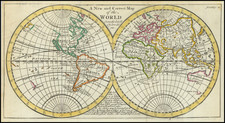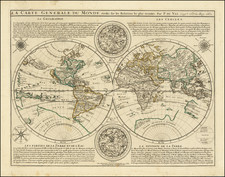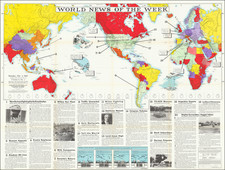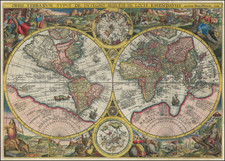Important Map Archive Illustrating the Birth of Post-World-War-II National, International, and Transcontinental Aviation.
Working map archive of L. Welch Pogue, Chairman of the Civil Aviation Board from 1942 to 1946, illustrating the birth of the Post-War civil aviation system at the end of World War II.
The maps were printed and annotated in the pivotal period at the end of World War II when the United States, Great Britain, and other nations established a system for governing peacetime aviation around the world. The maps reflect the process through which the highest-level decisionmaker for the United States established that nation's policies.
One map from the collection shows "Principal Air Routes of the British Empire" as of 1945. It includes hand-drawn routes in red, blue, and green ink. The dashed-green routes represent "Principal New Routes Proposed for Post-War Operation (Unofficial), whereas the other routes are divided between those in operation and those which were suspended during the war. The archive also includes CONFIDENTIAL (as opposed to RESTRICTED) version of the map, where the routes have been printed. This illustrates Pogue's access to cutting-edge information about the Post-War Air Route planning.
Composition of the Archive
The base maps primarily consist of large separately-issued charts of the world on equidistant projections, most of these charts were prepared for the U.S. Armed Forces. On some of the charts, air routes are printed, while on others Pogue has drawn real and projected routes.
The second group consists of a large assortment of separate U.S.-state maps published in the early-to-mid 1940s (not illustrated). A third group consists of separate National Geographic maps that were evidently used as reference material in the planning process (not illustrated).
The collection also includes documents related to Pogue's government career and awards he received later in life. There is a contemporary photographic copy of F.D.R.'s signed appointment of Pogue to Chairman of the Civil Aviation Board (not illustrated).
L. Welch Pogue, Architect of Post-War Civil Aviation
Lloyd Welch Pogue (1899-1903) was an American lawyer and civil aviation official who was instrumental in the Chicago Convention of 1944 and the growth of the U.S. Civil Aviation Board.
Pogue was born in Grant, Iowa in 1899, and was home-schooled by his mother after chores until 8th grade. He later attended Grinnell College and the University of Nebraska where he was student body president. In 1926 he graduated from the University of Michigan's law school. He received a doctorate of law from Harvard in 1927.
Pogue joined the nascent Civil Aviation Board in 1938 and within six months had risen to general counsel.
Pogue was instrumental in the 1944 Chicago Convention, which established vital transnational air treaties among more than 90 countries. The treaties allowed peacetime flights over national airspace without requiring stops in each country and it made English the international language of air traffic control.
According to his Washington Post obituary:
The president assigned him to analyze how the United States could benefit in the postwar configuration of commercial air travel, and one of Mr. Pogue's key legacies in that area was his leadership during the Chicago Convention.
He helped kill off a proposal for a single world airline and showed other countries that their own national airlines would not suffer through treaties.
He also developed a savvy way to keep the president informed.
"President Roosevelt did not want to be obliged to read any memorandum over one page in length," he once wrote. "He called long memoranda 'trash' (only he used much stronger language). Most aviation problems were technical in nature. They could not be treated well on only one page.
"So, I decided this way of defeating that trait. I simply divided the memorandum into as many half-pages as necessary, and then I sent them to him, one at a time, over several days; he never failed to read them all as I found out when I next saw him."
After his work in the public sector, he started Washington law firm, Pogue & Neal. In 1967, his firm merged with a large Cleveland-based law firm to become Jones, Day, Reavis & Pogue. Pogue was managing partner of the Washington office before stepping down in 1979. Today the firm is known as Jones Day and is one of the nation's largest.











![[ World on Mercator's Projection ] Mappe-Monde suivant la projection de Mercator -- 1832](https://storage.googleapis.com/raremaps/img/small/99031.jpg)
![[Grotto of Tethys -- Versailles] Le Soleil qui se couche dans la mer / Le Globe de la Terre, divise en six parties.](https://storage.googleapis.com/raremaps/img/small/79606.jpg)



